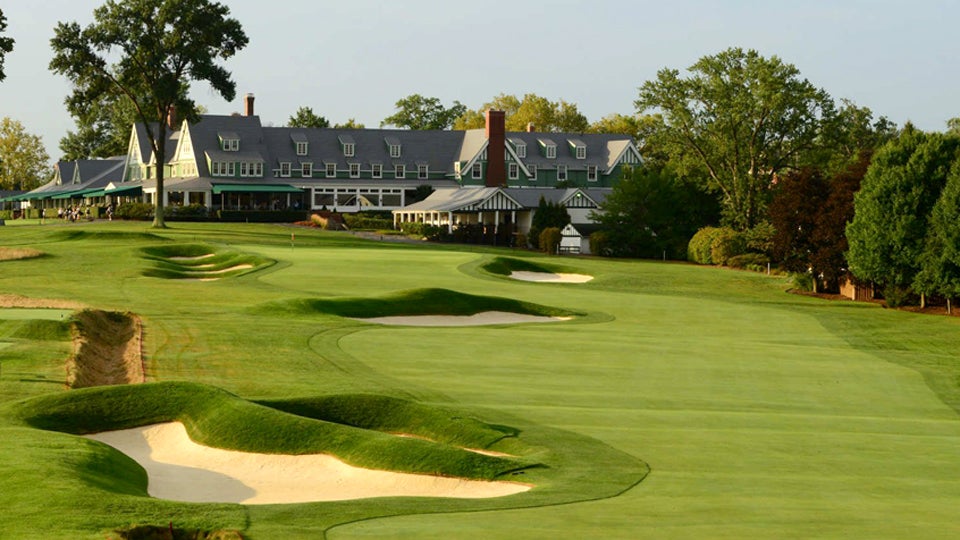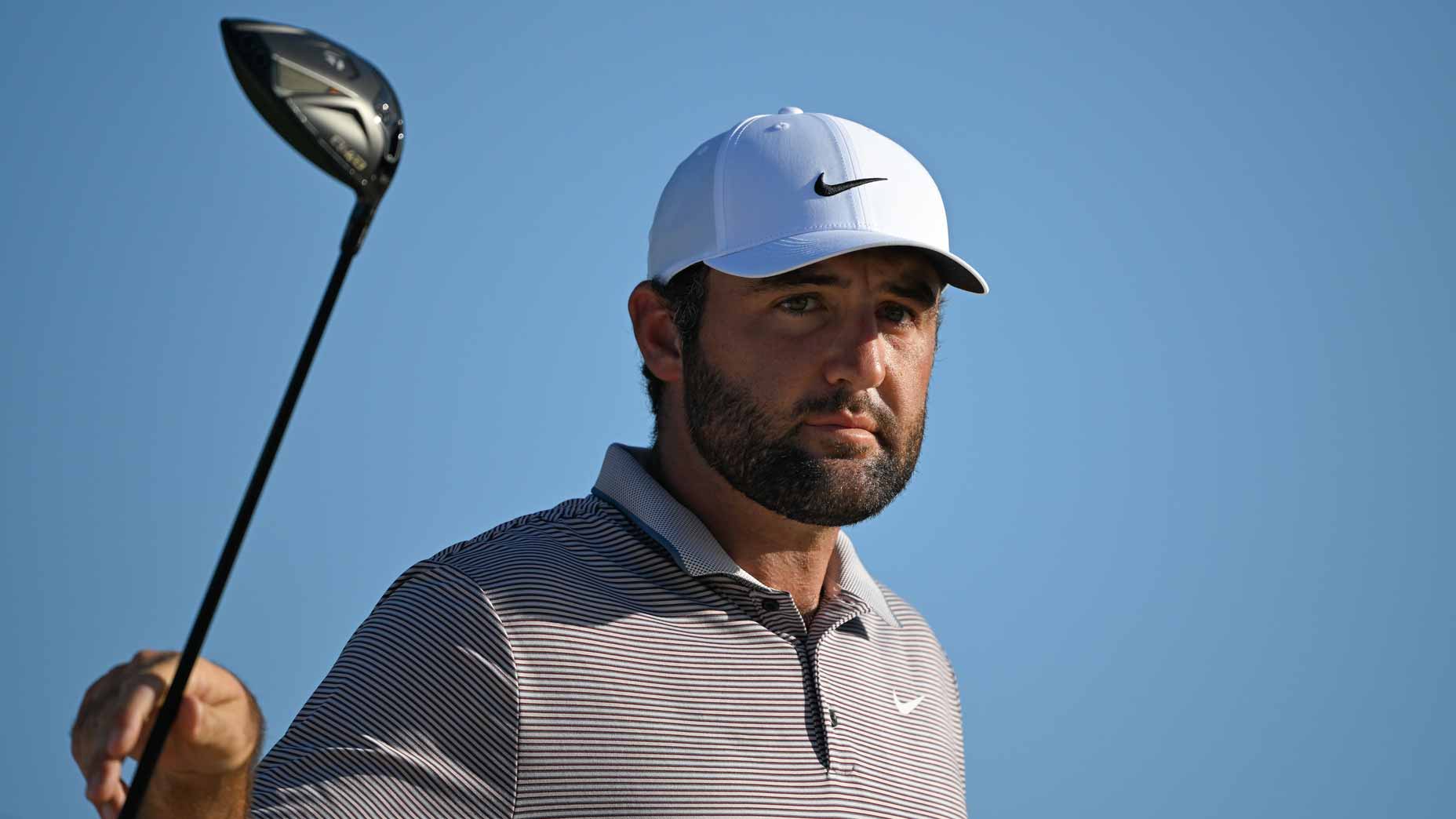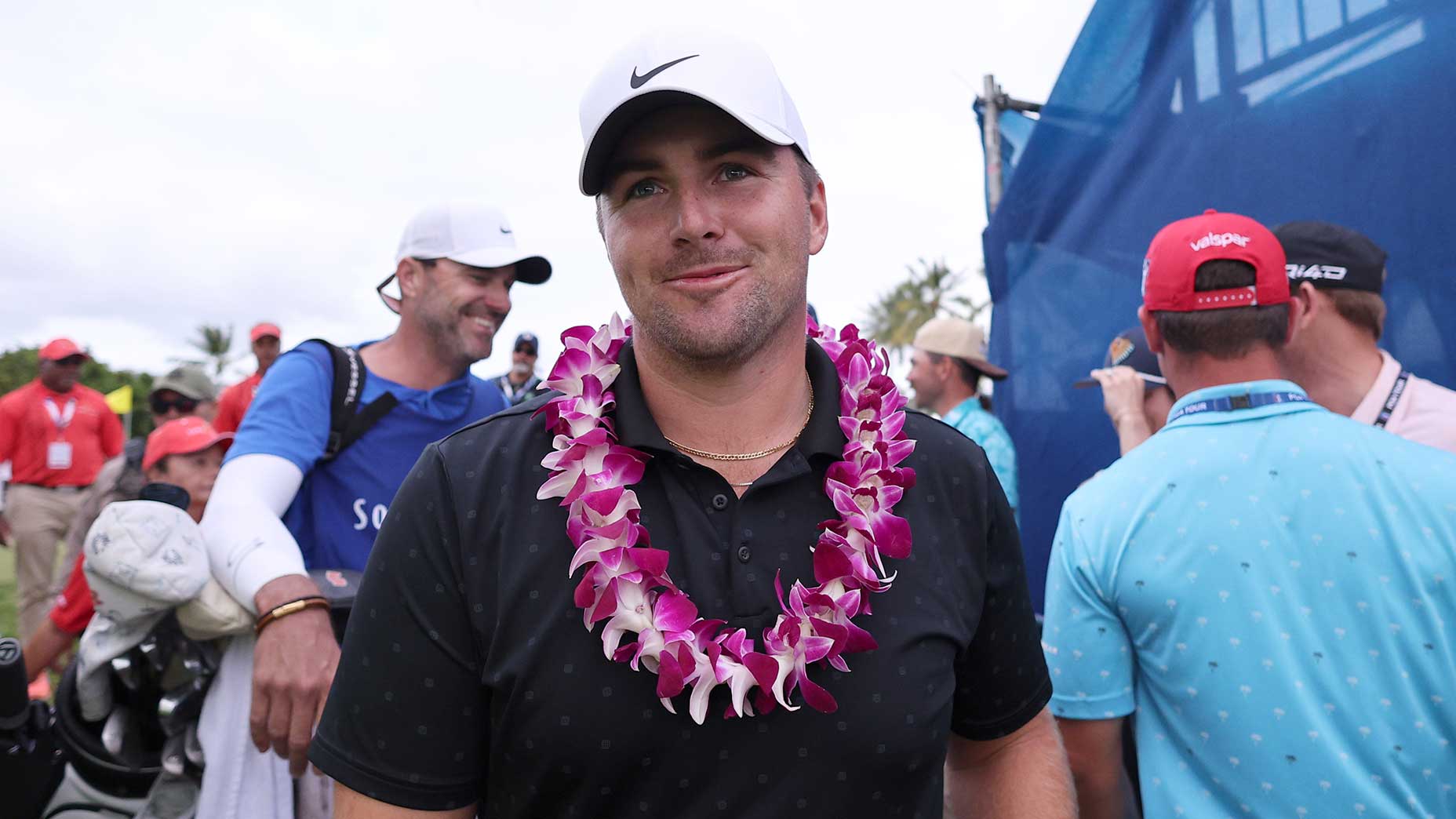The Fox golf gang, various USGA bluecoats, Jordan Spieth and his touring brahs, they’ll all tell you the same thing: Oakmont is hard–hard but fair!–most likely the hardest course in America, quite possibly the hardest course in the world.
That doesn’t mean it has to be. If you gave Oakmont some kind of golf course tranquilizer—mowed the rough, grew the fairway grass, watered the greens—you’d have another curvy, old-line, private-club course that would stand alongside dozens of other curvy, old-line, private-club courses in the affluent suburbs of Pittsburgh (where Oakmont sits so proudly), Philadelphia, New York City, Rochester, Boston, Chicago and some other cities that enjoyed turn-of-the-last-century megawealth.
But don’t hold your breath. Oakmont’s not getting that makeover. Not now, not ever. Throughout golf, people are talking about making the game kinder and gentler. Everywhere, that is, except Oakmont. Here’s the Oakmont view of the world: First there was Calvinism, then there was golf.
The club’s founder and guiding light, Henry Fownes, believed in hard as a traditional golfing value, and his spirit has pervaded the course ever since its 1903 opening—as a par-80. Hard in every sense: firm (weather permitting) and, more significantly, resistant to scoring. That’s why Johnny Miller’s Sunday 63 in the 1973 U.S. Open is widely regarded as the greatest round ever played. Arnold Palmer, who lived 35 miles down the road in Latrobe, was tied for the lead through three rounds. Miller posted early and watched Palmer play in on TV. Writing about his win years later, Miller said, “When Arnie missed that [four-foot] birdie putt on number 11, it was clear: He couldn’t catch me. He couldn’t shoot one under to tie me or two under to beat me—not at Oakmont under U.S. Open pressure.” Not at Oakmont.

For next week’s U.S. Open, Oakmont will play as a par-70. (It’s a 71 for the members.) Despite a wet spring, the sloping greens—the course’s trademark and ultimate defense—are as hard as a dance floor. Bubba Watson’s moonshot 9-irons will land on them with an astounding thud, and you’ll seldom see guys reaching for their ball-mark repair thingies. If some golfing god—Louis Oosthuizen, Zach Johnson, Danny Willett and other experts in on-the-ground golf—should somehow break 280, you will see your share of despairing members in the creaking clubhouse in the dusk of Father’s Day. “If you’re not a sadist when you join the club, you are after a couple of years here,” says Bob Ford, the club’s mild-mannered and longtime pro.
MORE: 18 Most Difficult U.S. Open Venues, Ranked
Fownes, a Pittsburgh iron manufacturer, felt that hard golf built character. Golf to him was not a game that one played. (It was his son, W.C., who famously said, “A shot poorly played should be a shot irrevocably lost.”) In the Fownes era, and ever since, people joined Oakmont seeking punishment, and to this day members don’t want to see their guests with big smiles on their faces. They want them to go forth into the world and spread the word: Hardest course I’ve ever played. The club hires superintendents who understand that tough but fair is as important to Oakmont as trust but verify was to Ronald Reagan. You’ve never seen a halfway house with a better selection of hard stuff.
There are no shade trees at Oakmont. There are next to no trees at all. (Good luck finding something to aim at. It’s Scotland on the Allegheny in stifling heat and, often, no breeze.) Let-up holes? Oakmont doesn’t do let-up holes. You want to go around the course with one ball? Then drive it in the fairway, as Hogan did with his eagle eye and no-glove grip, en route to winning the Open in ’53. (Here are some other winners of major events at Oakmont: Gene Sarazen, Bobby Jones, Sam Snead, Jack Nicklaus, Larry Nelson, Ernie Els and, at the 2007 U.S. Open, Ángel Cabrera, the future Hall of Famer.) Can’t get your ball up fast enough to escape the Oakmont drainage ditches? Dig a ditch in your backyard and learn the shot! Your fourth putt is longer than your third? Welcome to the Oakmont power lip-out, folks. Oh, and whatever you do, do not hold up the group behind you! How about a little common courtesy, people, courtesy being one of the hallmarks of the game?
Oakmont is nothing if not traditional. That’s one of the reasons the USGA has taken its flagship championship, and the hardest event in golf, to Oakmont more than any other course. Oakmont and the USGA—it’s a perfect match! This 116th U.S. Open will be the ninth in the borough of Oakmont, Pa.
Bob Friend, the longtime pitcher for the Pittsburgh Pirates, retired from baseball in 1966 and joined Oakmont five years later. “I’ve been shellacked by Willie Mays, Hank Aaron—some of the greatest hitters ever,” says Friend, now 85. “I’ve been shellacked by Oakmont a heck of a lot more.”
MORE: 39 Father’s Day Gifts for Your Golf-Loving Dad
The righthander’s son, Robert, who played the PGA Tour in the 1990s, grew up caddying and playing at Oakmont, but he entered the club championship only once, as a 21-year-old amateur. He won by 13 shots. “The next year Mr. Ford basically said that I shouldn’t enter, shouldn’t defend my title, that I had moved on,” Robert says. The unspoken part was this: A 13-shot win isn’t Oakmont. You don’t want to send out the wrong message. You know, that golf (for some people anyway) is easy. Oakmont doesn’t do easy.
Oakmont is a country club in name only. It’s not la-di-da. Alex Lawson is a fourth-generation member and the reigning junior club champion. His maternal grandfather, John Birmingham, has been a member for 61 years, and at 76 he shoots or breaks his age routinely. The grandson, now 17 and finishing his junior year at Fox Chapel Area High, can drive the ball 320 yards. He shot 78–66 last year to win the junior title and get grillroom paint, his name in black letters on a gold-tinged wooden board. Do you think his victory got him any respect from the other Oakmont juniors? Not according to Alex: “I bogeyed the last two and they’re like, You choked!” Sixty-six! Tough crowd.

Alex’s sister, Emilie, graduated from South Carolina last month. Alex tells a story, with unmistakable glee, about being on the range with Emilie and their grandfather. Emilie was 14, and she and her grandfather were playing closest-to-the-pin to five flagsticks on a mown green surrounded by a firm, fast runoff. The shots were maybe 30 to 70 yards long. Emilie was hitting open-faced wedges, à la Paula Creamer, winner of the 2010 U.S. Women’s Open at Oakmont. Gramps was hitting hooded bump-and-runs, à la Sam Parks. (Birmingham logged many, many rounds with the winner of the ’35 Open at Oakmont.) One bounce and here come the brakes. As Alex tells the story, Grandpa hit it inside Emilie nine of 10 times and said, “‘I’ll beat you nine out of 10 every time if you keep playing shots like that.’ And my sister started crying. Grandpa made her cry!”
Birmingham, who played in the 1968 U.S. Open at Oak Hill but missed the cut, doesn’t deny it. But he has an addendum. “She became a very good player,” he says. “Did you know she won the women’s club championship twice?” Grillroom paint. Alex didn’t include that part. Tough crowd.
By the way, you know how some country-club kids think golf balls grow on trees and give up their searches for strays at about the 42-second mark? Alex is not like that. No Oakmont member is like that. If he hits his ball in the rough—and you are going to hit your ball in the rough at Oakmont—he’s going to find it. When he played the other day, 100 or more Oakmont crew members were on the course, in their khaki pants and white shirts, many of them tending to the rough. That is, watering the rough, measuring its length, looking for thin spots that needed attention. Over the green on the shortish par-3 6th hole (194 yards from the back tee), Alex nodded approvingly as two men raked the long grass in front of the bleachers toward the green. “That’ll make balls bury even deeper!” he said merrily. The kid’s a sadist. He’s an Oakmont member.
Before that after-school round Alex visited with John Zimmers, the Oakmont superintendent, in his office at the back of the range. Like almost everybody at Oakmont of a certain age, Zimmers venerates Palmer and has pictures of him on his walls, some of which were made from felled Oakmont pin oaks when thousands of trees, not part of the original design, were removed from the course between the 1994 and 2007 Opens. When Arnold was a teenager, his father, the course superintendent and head professional at Latrobe Country Club, was offered the job as Oakmont’s superintendent. Arnold was beside himself with excitement. Oakmont! But in the end his father turned down the job, telling his son, “We have everything we need right here.”
MORE: The History of the Stimpmeter Starts at Oakmont
You can draw a straight line from Palmer to Oakmont, including Arnold’s keen appreciation for tough courses and his understanding of heartbreak’s important role in golf. He played in his first U.S. Open at Oakmont, as an amateur in 1953. He played his final U.S. Open at Oakmont, as the game’s most celebrated figure, in 1994. He missed both cuts. He lost the ’62 U.S. Open to 22-year-old Jack Nicklaus in an 18-hole playoff at Oakmont. In ’73 he was in the hunt until late on Father’s Day. Zimmers points to a 2007 picture and says, “This is from Arnold’s last visit here.” You can hear the sadness in his voice.
But before long Zimmers has his game face back on. “Where else is somebody going to shoot 115 without losing a ball!” he says. He’s a wiry man with a shaven head and a good sense of humor. He says, “I like to see people suffer.” His bosses, the club membership, feel the same. “The members will get upset if their guests go home and did not have a miserable time!” Zimmers adds.

Then, with a certain solemnity, he shares the memorable words that Palmer passed on to him: “Let Oakmont be Oakmont.” What sage advice.
Alex was listening intently. He doesn’t come to Oakmont to hang out. He comes to work on his game, to play the course through dusk and, this summer, to caddie. The Oakmont mystique for him is not Bobby Jones and Jack Nicklaus and Johnny Miller. He’s like every kid you know, living in the here-and-now. He tells Zimmers, “I’m walking through the locker room, and there was Jim Furyk!” Alex is a Rory man himself. His buddy is a Jason Day guy. They fight about who is better all the time. They haven’t come to blows—yet.
Bob Ford—Mr. Ford to Alex and every young person at Oakmont—is retiring at the end of this year, after 37 years on the job, though he will stay on as director of golf. (In the winter he’s the head pro at Seminole Golf Club, in South Florida.) Ford is a superb player, but the pleasures of Oakmont for him are not the many good scores he has made there but things that are far more amorphous. He speaks of pleasures of a kind: “The view from the back tee on 4, the highest point on the course. Now, with the trees out, you can see practically the whole course from there. The 25 years we lived in the pro’s cottage behind the shop, raising our three kids there.” He goes on in that vein.
Other members and guests and employees cited things that had nothing to do with the brutal nature of the course. Alex talked about Oakmont at sunset, “when the sky turns red and you can see all the humps on the fairways.” (Touch of the poet there, kid!) An employee talked, with a kind of pride, about how you cover up your tats when you come to work “because Oakmont just isn’t a tattoo kind of place.” A caddie, Jeromie Meabon, described being out for two recent practice rounds with Rickie Fowler, Justin Thomas and Smylie Kaufman, “looking at them looking at the course, trying to figure it out, trying to find a way to get in the mix.” Zimmers talked about the beauty of the course’s drainage ditches once the club decided to clean them up and clear out the growth early in his tenure. Mike Davis, the executive director of the USGA, remembered hearing his father talk about how in the 1940s he would play the public course that used to be right next door, “and how he would look at Oakmont’s 2nd green through the fence and just be in awe of its speed.” Birmingham talked about being in the locker that his father started using in 1938. Robert Friend talked about playing in the Druckenmiller Cup, an annual event started by a longtime member and successful investor, Stanley Druckenmiller, and how “after dinner we play shots off the porch teed up on dinner rolls to the 18th green.” Bob Friend talked about bringing his old Pirates teammates—Dick Groat, Ralph Kiner and Bill Mazeroski—to the course. It didn’t matter if everybody shot 100. They were playing the course where Jones and Hogan and Nicklaus had won, and where Palmer did not. Golf, like baseball, is about futility.
Oakmont is not resting on its laurels and its sepia-toned past and the fact that the Stimpmeter was inspired there. (The greens will Stimp at around 13 for the Open. They will be faster for the Druckenmiller Cup.) This is not a club on permanent rewind, not at all. The most famous photograph ever taken at Oakmont is the black-and-white shot of Arnold and Jack coming off the 18th green after their playoff in ’62. Arnold is looking squarely at Jack, who came to Oakmont as both a newly minted pro but also as the reigning U.S. Amateur champion. They’re walking and shaking hands and heading off to some great, unknown future. Alex Lawson has walked by that photograph on a clubhouse wall a thousand times, but he took eight seconds to identify Nicklaus and needed “half-and-half” as a hint to come up with Palmer’s name.
It doesn’t matter. The kid, like all kids, is all about the here-and-now, the here-and-now, the here-and-now. His here-and-now is the U.S Open—at Oakmont. “My buddy’s got an inside-the-ropes pass,” Alex says. “O.K., he claims he does. I’m taking Rory. I just think it’s gonna be Rory.” He’s seen McIlroy on TV plenty, and his grandfather has seen him at Seminole. Now Alex is going to get to watch Rory McIlroy, his golfing hero, live and in person for the first time. His voice is actually quivering.
Yeah, well—what would Rory pay for Alex’s second-round 66 from last year’s junior championship? Plus, grillroom paint.







